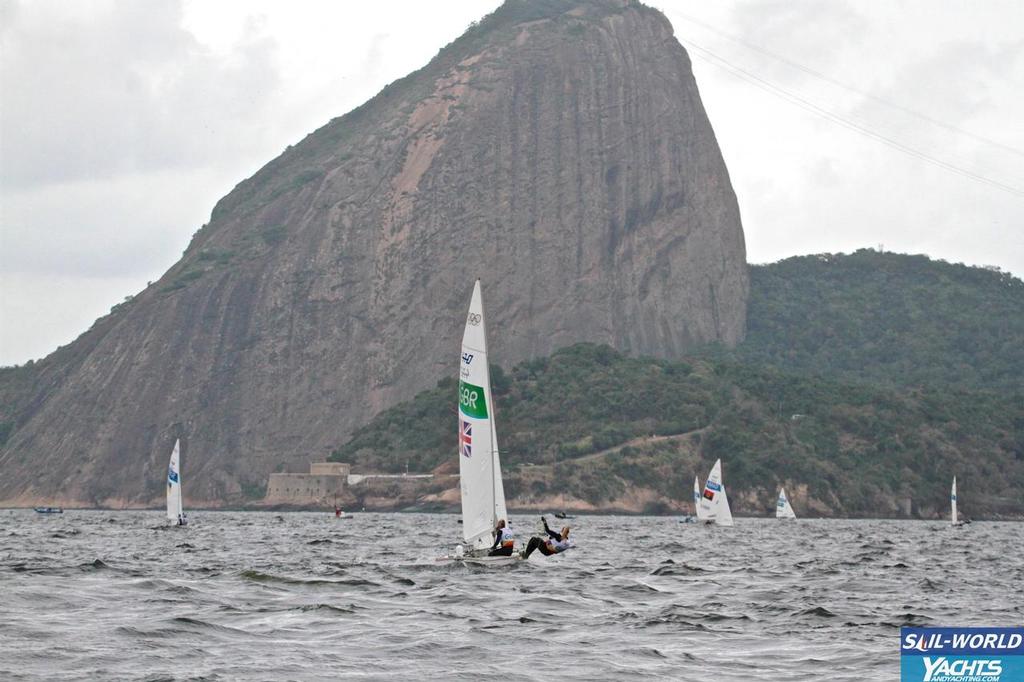Gladwell's Line - The challenges of Guanbara Bay
by Richard Gladwell, Sail-World.com NZL on 11 Aug 2016

Olympic Day 3 014 (2) Richard Gladwell
www.photosport.co.nz
The decision to run Medal Racing on the Pao de Acucer, probably won't be remembered as one of the brightest of the 2016 Sailing Olympics.
Over shadowed by a 1300ft tall granite and quartz mountain in the shape of a sugarloaf, the bay suffers from dramatic wind shifts, and huge variance in wind pressure.
While the Sugarloaf takes the blame, its partners in crime would appear to be a succession of similar mounts that encircle the bay. Pão de Açúcar to give the sugarloaf-shaped landmark its correct name flanks the bay to the left and to the right is Corcovado - which serves as a 2300ft high plinth for the statue of Christ the Redeemer.
Between is a myriad of wanna-be peaks backed up with tall apartment blocks along the white sand beach.
In short, it looks like the remains of a kids sandcastle competition. Small wonder the incoming sea-breeze gets tired and bewildered as it fights a way through this man and nature-built landscape.
The area is picturesque for sure, but it is a sailing hell-hole if the results from the first three days of the Olympic regatta are any guide.
There is some indication of what is happening in the results, but on the water the racing is shocking. Competitors with very comfortable leaded or separation from the pack suddenly lose the lot in literally a few metres.
Upwind it is largely a matter of being in the right place at the right time and being very good at puddle jumping.
The patches of wind coming down the course are very obvious with the assistance of a very good pair of sunglasses to reduce glare to a minimum. Then it is a matter of threading your way up the track.
The invisible culprit is the ferocity of the breeze when it does come through is surprising.
The wind doesn't come in puffs as we know it in most locations put more in williwaws, perhaps not surprising given the topography.
The effect is the downwind a leader is vulnerable, very vulnerable to a boat from behind which gets a short boost from a williwaw which will often be double or triple the strength of that for a nearby boat. Doesn't take too long to take a big bite out of a leader when they are in a very soft spot and you are planing hard for a few seconds.
The technique of riding these puffs down the course in the conventional manner doesn't work either as they turn off as quickly as they arrive.
It is pure luck.
On the medal course, used for the Finns on Day 2, current world champion Gilles Scott talked of 40-50 degree wind shifts as he walked through the Mixed Zone after racing had concluded.
Is this really the sort of race area Sailing should be using for its Medal Racing?
Sure it might be very close to a lovely beach, and the people living in the many apartments will get a prime seat at the sailing stadium, but having medals determined in this way is not the way we should be running the Sport.
The Nothe course at Weymouth presented its own challenges and was true stadium racing. It at least had a clear run from the breeze as it approached the race course. But that is not the case on the Pao de Acucer course - the closer you get to to the shore the worse it gets in any wind direction from S through NNNW.
In Qingdao, the 2008 Olympic medal races were conducted alongside a massive sea wall - that did have some effect in the early Medal racing which was sailed in lighter winds. But at least it was consistent because of its height.
And of the course the final couple of days when the strong onshore wind came in provided some absolutely unforgettable racing - everything that the Medal races were supposed to provide.
The practical approach for competitors to the Pao de Acucer Medal race course is to be extremely consistent in the racing when they are not at that venue (and that is accepting all the nuances outlined above of racing in Guanabara Bay generally.
The idea will be to go into the Medal race being in a position where the double points race cannot affect the overall Medal result.
That is obviously a very utopian view, and completely defeats the purpose of holding Medal Racing - but it is the reality of the Rio de Janeiro Olympic Regatta.
The alternative is to scrap the Medal Racing altogether on that course and just draw the placings out of a hat, calculate the points, double the score for the race as prescribed, and then hold the Medal ceremony.
Alternatively, the race officers could refuse to race on it and do what was done yesterday with the Nacra 17's who pulled out of the area and went further back out into the in the bay, where a slightly more stable direction of wind could be found.
The sailors deserve nothing less, and the spectators might just have to accept that a lot of time and effort have gone into these campaigns, and that deserves some respect from organisers.
If you want to link to this article then please use this URL: www.sail-world.com/147268